|
Launch of the Lester James Peries and Sumitra Peries
Foundation:
Preserving cinematic legacy for posterity
By Ranga CHANDRARATHNE
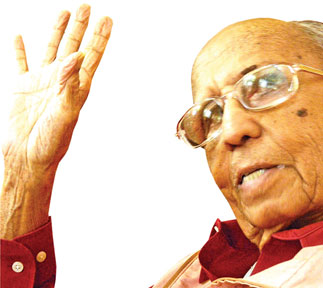 The Lester James Peries and Sumithra Peries Foundation, was launched
recently in a simple but dignified ceremony at the BMICH. The ceremony
commenced with the welcome address by Trustee Yadamini Gunawardena (
Minister Dinesh Gunadardena’s son) outlining the objective of the
Foundation. The Lester James Peries and Sumithra Peries Foundation, was launched
recently in a simple but dignified ceremony at the BMICH. The ceremony
commenced with the welcome address by Trustee Yadamini Gunawardena (
Minister Dinesh Gunadardena’s son) outlining the objective of the
Foundation.
Apart from preserving the cinematic legacy of the doyen of Sri Lankan
cinema Dr. Lester James Peries and pioneer woman filmmaker and one time
Sri Lankan Ambassador in France Sumithra Peries, one of the cardinal
objectives of the foundation is to set up a ‘National Cinema Archives’
in Sri Lanka with the aim of preserving Sri Lanka’s cinematic legacy for
the future generation. Among the objectives are the promoting the art of
filmmaking and Children’s Cinema in Sri Lanka.
A message by President Mahinda Rajapaksa passing on good wishes to
Dr. Lester James Peries and Sumithra Peries and the Foundation was read
out by Ravindra Randeniya. The foundation’s official website WWW.
ljpfoundation.org was officially launched by Speaker Chamal Rajapaksa.
The Foundation was incorporated by an Act of Parliament and the proposal
for the Bill was made by Malini Fonseka and was seconded by J.R.P
Sooriyapperuma.
Indian filmmaker Padma Vibushan Dr. Adoor Gopalakrishnan, who is an
admirer of Dr. Lester James Peries and Sumithra Peries cinema, described
Dr. Lester James Peries as “a remarkable filmmaker – one of the greatest
living filmmakers in the world today"
In his remarks, Dr. Adoor Gopalakrishnan, stressed the need to set up
a ‘National Cinema Archives’ describing that "Both our countries are
blessed with humidity and heat which are the real enemies of films".
Dr. Lester James Peries oration
The focal point of the launch was the inaugural Dr.Lester James
Peries oration which was delivered by Prof. Wimal Dissanayake of the
University of Hawaii. In the oration, Prof. Wimal Dissanayake observed
,“Lester James Peries is unquestionably the greatest filmmaker that Sri
Lanka has produced. He is also among the greatest of Asian filmmakers.
His work can be approached profitably from diverse conceptual vantage
points . In this talk, my chosen conceptual vantage point that if the
social imaginary which opens a useful theoretical space for film
analysis.
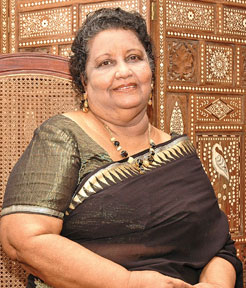 |
|
Sumithra Peries |
The first Sinhala film ‘Broken Promise’ was made in 1947. This film,
directed by B.A.W. Jayamanne., was based in a stage play, had a great
impact on Sinhala audiences. He went on to direct a number of other
films that were based on stage plays. During the 64 years of its
existence, Sri Lankan cinema had made appreciable progress; it has had
its ups and downs.The recently concluded ethnic war, which lasted for
about three decades, severely and adversely impacted the local film
industry. Despite this, a number of Sri Lankan filmmakers went on to
make films that have won international acclaim. Among these filmmakers
Lester James Peries is the foremost; he is the doyen of Sri Lankan film
directors. He has received the highest honours bestowed on film
directors in India, France and Sri Lanka. Apart from Peries there are
other talented filmmakers such as Vasantha Obeyesekere, Dharmasena
Pathiraja, Sumithra Peries, Prasanna Vithanage, Asoka Handagama,
Vimukthi Jayasundera….”
One of the principal cultural theoretical theses that Prof.
Dissanayake who is an international expert on Asian Cinema, invoked was
cultural modernity. He pointed out that cinema served as both a
‘reflector and shaper of cultural modernity. “As we examine the growth
of cinema in Sri Lanka, one fact that emerges clearly is that from its
very inception it was associated with the question of cultural
modernity. Cinema is both a reflector and shaper of cultural modernity
in the island. During the four stages of expansion Sri Lankan cinema
manifested different interests and investments in confronting cultural
modernity.
Before we discuss how cultural modernity was captured in films, it is
important to describe what is meant by this term. Modernity signifies
not only cognitively understood categories such as science and
rationality but also values like secularism, individual freedom and a
sense of equality.
The way tradition inhabits modernity has to be teased out carefully
because the easy binary of tradition and modernity as polar opposites is
not borne out by the facts. Max Weber articulated the view that a
defining trait of modernity is the important emphasis placed on choice
as an aspect of one’s individuality. What is evident now is that the
question of choice is far more complex than Weber believed.
Social theorists saw modernization as a neo-evolutionary narrative
which pointed to a universal path that led to social development
(Weber,1947).. It was their firm conviction that there was only one
pathway towards modernity and it was the one that was traversed by
Europeans. However, the experience of developing societies has proved
otherwise. What has firmly being established is that there are many
modernities, and the velocity of the modernization process varies
considerably according to the culture of the society concerned.
Therefore, it is of the utmost importance that we talk in terms of
cultural modernities rather than discuss it as a monolithic term with
unambiguous meanings. This idea of cultural modernity is important
because it is precisely what we see in Sri Lankan films.
In the first phase of Sri Lankan cinema, questions of subjectivity,
clash between the individual and collectivity, which are marks of
modernisation were presented in culture-specific terms, often very
crudely. The second stage witnessed the spread of urban consciousness,
secularism, and scientific rationality as they impinged the local
culture. In the third stage, ideas of socialism, youth unrest, problems
of unemployment, alienation of youth, which were all inevitable
concomitants of the modernisation process, found cultural expression. In
the fourth phase, the ferocity of the ethnic conflict and its impact on,
and implications for, the state, civil society, rule of law and so on
began to be explored in terms of the vocabulary of local culture.
Therefore, it can legitimately said that during the fur sages of
development of Sri Lankan cinema, the idea of cultural modernity figured
very prominently. “
Citing Dr. Lester James Peries's trilogy of films Gamperaliya ( The
'Changing Village,') Kaliyugaya ( 'The Age of Kali') and Yugantaya ('The
End of an Era') , Prof. Dissanayake pointed that the person who made the
important conjunction between cultural modernity and social imaginary
was Dr. Lester James Peries. " .. a significant moment in the history of
Sri Lankan cinema, this idea of cultural modernity intersected with the
notion of the social imaginary in interesting ways.
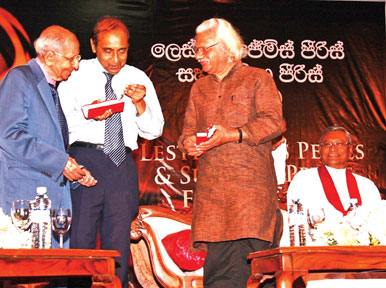 |
|
Dr. Lester James Peries, Dr. Adoor
Gopalakrishnan and Prof. Wimal Dissanayke at the launch |
This marks an important moment. The person responsible for the
conjunction is Lester James Peries. His trilogy of films The 'Changing
Village,' 'The Age of Kali' and 'The End of an Era', based on three
highly acclaimed novels by the foremost Sinhala novelist, Martin
Wickremasinghe. precipitated this moment. With 'Line of Destiny', Peries
inaugurated the art cinema in Sri Lanka; it constituted a formidable
challenge to the existing and bemused film culture, such as it was.
However, it is with 'The Changing Village' (Gamperaliya) that he found a
perfect concordance between the chosen experience and the desired supple
form leading to a cogent lyrical poise.
While 'The Line of Destiny 'represented, in terms of cinematic art, a
bold attempt to transcend the formula-guided cinema that was prevalent
at the time, the experience itself did not carry complete conviction for
me as some one who was born and bred in a remote village ( similar to
the one depicted in the film); things did not quite add up. However,
with the production of 'The Changing Village' (Gamperaliya), 'The Age Of
Kali' (Kaliyugaya) and The End of an Era' (Yuganthaya,) Lester James
Peries was able to fashion a cinema that was experientially authentic,
that carried the requisite social density and cultural modulation of
meaning and that carved out a concomitant cinematic poetics and
representational strategies for achieving his artistic ambitions. While
Nidhanaya, (TheTreasure) in my judgment, is Peries' most accomplished
work in terms of willed cinematic art, and Wekanda Walauwa (Mansion by
the Lake) is replete with Chekhovian visual symbolism, in this short
essay I wish to focus on The 'Changing Village', 'The Age of Kali' and
'The End of an Era', made in 1963,1983, 1985, respectively as
representing Peries' first measured attempt to explore the indigenous
social imaginary in terms of cinematography.; his cinematic fingerprints
are unmistakably present in these works.
Indeed, it was 'The Changing Village' that captured most powerfully
the birth of this moment. In response to these films, Peries found, what
most conscientious filmmakers are incessantly looking for - the supreme
spectator with discernment.
The term social imaginary has been put into wide academic circulation
by the eminent philosopher Charles Taylor.(Taylor 2004). This is indeed
a concept that I have deployed productively in some of my books on
cinema. As Taylor remarked, the concept of the social imaginary
encompasses something much wider and deeper than analytical schemes and
intellectual categories that scholars are in the habit of pressing into
service in there investigations.
He calls attention to the 'ways in which they (people) imagine their
social existence, how they fit together with others, how things go on
between them and their fellows, the expectations which are normally met,
and the deeper normative notions and images which underlie these
expectations.' Here, it is evident, that Taylor is focusing very
insistently on the existential and experiential dimensions of social
living. "
In the final analysis of Dr. Lester James Peries' cinema, Prof.
Dissanayake drew home the point that 'realism' for Dr. Peries is not a
mere 'mimetic reflectionism' but 'a poetic recreation and cinematic
re-coding', "Lester James Peries' attempt to capture the social
imaginary of Sri Lanka is that it is buttressed by his deep conviction
of the efficacy of cinematic realism and the importance of humanism as a
functional creed.
Realism, for him, is not merely a form of mimetic reflectionism but a
poetic re-creation, cinematic re-coding, of social reality where the
locus of meaning shifts to history and its inflections of human lives.
What Peries has sought to re-create in this trilogy of films is not raw
verisimilitude but poetic verisimilitude.
Peries, in my judgment, sought to go beyond the kind of realism
valorized by film theorists such as Andre Bazin, (Bazin, 1967) who urged
the importance of films as a neutral medium for recording natural and
cultural phenomena and viewed with great suspicion on the efforts if a
filmmaker at authorial intervention. Lester James Peries, on the other
hand, while recognizing the importance of verisimilitude also underlined
the significance of codes and conventions, both cinematic and cultural,
and the creative powers of the filmmaker in modulating reality and
giving it a sharper definition. The eminent film critic, Siegfried
Kracauer (1960) once remarked that, 'the cinema can be defined as a
medium particularly equipped to promote the redemption of physical
reality.'
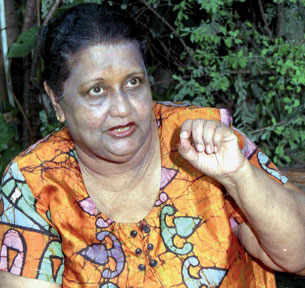 |
|
Sumithra Peries |
This is precisely what Peries intended to do. He wanted his created
cinematic images to be true to Sri Lankan life and society; at the same
time, he wanted them to shine with a modulated lyricism. Similarly,
humanism, in his judgment, is not merely a mind-set but also a mode of
feeling and a part of his representational arsenal. His decision to
select three critically acclaimed Sinhala novels for cinematic
representation, his poetic lyricism, and sensitivity to indigenous
cultures on the move enable him to create three works of cinematic art
that resonated with the social imaginary of the people. "
Dr. Lester James Peries as a pioneer filmmaker
The launch of the Dr. Lester James Peries and Sumithra Peries also
marked the Diamond Jubilee of winning the first-ever international award
in 1951. It was 'The Mioni Cinema Challenge Cup' presented to Dr. Lester
James Peries by the British Government for 'Soliloquy'. The launching of
foundation also marked a half a century for Sumithra Peries's brilliant
career in cinema. She joined Dr. Lester James Peries in 'Sandeshaya' as
an assistant director.
Looking back on Dr. Lester James Peries's trailblazing career in
Sinhala cinema and the evolution of Sinhala cinema from studio-shot
formula films to artistic films of international repute, what is obvious
is that it is Dr. Peries's pioneering attempt with the production of
Rekawa that altered the course of Sinhala cinema. 'Gamperaliya' (Change
in the Village -1964) which has recently been restored is still
appreciated worldwide by diverse audiences. It is one of the instances
where a cinematic masterpiece was made based on a classic Sri Lankan
novel by Martin Wickramasinghe. Gamperaliya as a restores classic is
considered as one of the ten best films of the twentieth century.
'Nidhanaya', (The Treasure),a brilliant cinematic exploration into
the human psyche is not only a superb cinematic analysis of human psyche
but also a masterpiece of Sinhala cinema, marked for its mature
cinematic diction which is peerless in the annals of Sri Lankan cinema.
A significant facet of Dr. Peries's career in cinema is the sheer
diversity of his creations; 'Gamperaliya' is recognised for its
non-dramatic and realistic depiction of the village, 'Madol Duwa' (The
Enchanted Island -1976) may be evaluated for capturing the lives of
youthful escapade in a Southern coastal village. A living legend, Dr.
Lester James Peries is the only Sri Lankan filmmaker, who belongs to a
generation of legendary filmmakers such as Akira Kurasawa, Satyajith
Ray, Ingmar Bergman.
Sumitra as a pioneering woman filmmaker
Sumitra Peries is the path breaking Sri Lankan woman filmmaker who
paved way for the entry of women breaking the monopoly of then male
dominated Sinhalese cinema.
Looking at her remarkable career in cinema which bequeathed the
nation a corpus of creations including Gehenu Lamai (1977), Ganga Adara
( 1980), Yahalu Yeheli (1982), Maya (1984), Sagara Jalaya ( 1988) , Loku
Duwa ( 1996), Duwata Mawak Misa ( 1997- based on novel by G.B
Senanayake) and Sakman Maluwa ( 2003- based on a short story by Godfery
Gunatilake), Sumitra Peries stands out as a Sri Lankan filmmaker who
realistically depicted the Sri Lankan woman from diverse aspects.
The character of woman portrayed in her films is not a prototype or
stereotype woman often valarised by cultural puritans but the one who
plays a dynamic and significant role in life as a mother. For instance,
in her film Duwata Mawak Misa, Sumitra portrays the close relationship
between a mother and a daughter not only in Sri Lanka but also in any
Asian society.
Feminist issues
What is noteworthy is that her approach to dealing with feminist
issues is neither sympathetic nor clinical but a realistic one.
Her maturity in the craft was amply demonstrated in Yahaluwo (Best
friends) in 2007. The film was made at the tail end of the conflict and
masterly depicts the dynamics of ethnic relationships among diverse
ethnicities in Sri Lanka through the eyes of a child of mix parentage.
Yahaluwo is so far the most sensible cinematic exploration of diverse
ethnic relations in Sri Lankan polity as the sub-text of the film. At
the same time, it is also a children's film.
Study and exposure
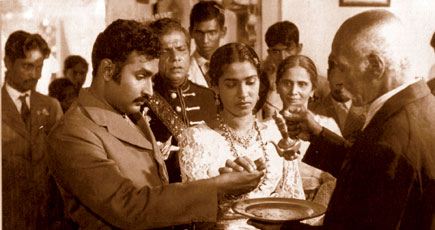 |
|
A scene from
Gamparaliya |
One factor which makes Sumitra Peries is her deep understanding, vast
knowledge and experience in the field of cinema. It was in 1950s that
she studied film making at the London School of Film Technique and
earned a Diploma in Film Direction and Production (1957-1959).
Significantly she was the only woman student at the time and began
working at Mai Harris, a subtitling firm for a short spell.
Sumitra's brother Gamini contacted Lester and checked the possibility
of her sister to work with him.
Lester agreed and Sumitra started the work as assistant director in
his second film Sandesaya. A filmmaking company called Cinelanka was
established in 1963 with Anton Wickramasinghe also Lester and Sumitra as
major shareholders.
Apart from serving the nation in diverse capacities such being a
member of the Presidential Commission for two years to conduct an
inquiry into Sri Lanka's film sector, a member of the Board of
Management of the Institute of Aesthetique Studies, Kelaniya University,
Sri Lanka, Sumitra Peries was the Sri Lanka's Ambassador to France. She
won the award for the best film director in fifty (50) years of Sri
Lankan cinema.
|

